June 2013. Forest fires along the Front Range of Colorado are making the national news already this year. The Black Forest fire between Denver and Colorado Springs, finally contained on June 20th after burning 14,000 acres, was the most destructive fire in Colorado history in terms of the number of houses destroyed – around five hundred. Last year’s Waldo Canyon fire burned in foothills suburbs north of Colordo Springs, and is said to be the most expensive fire in Colorado to date, with about 350 homes burned and more than $350 million in insurance claims.
Most of the several million people who live between Colorado Springs and Fort Collins have seen smoke from forest fires recently, but my bet is that not more than a dozen people have seen a Colorado Firemoth. One reason is that this moth is relatively rare. And that’s part of the problem: when this moth is rare, Colorado beware! This little moth has an important lesson to teach us about fire ecology in the Colorado Front Range. Before it can, more people have to see it, or at least be aware of its existence.
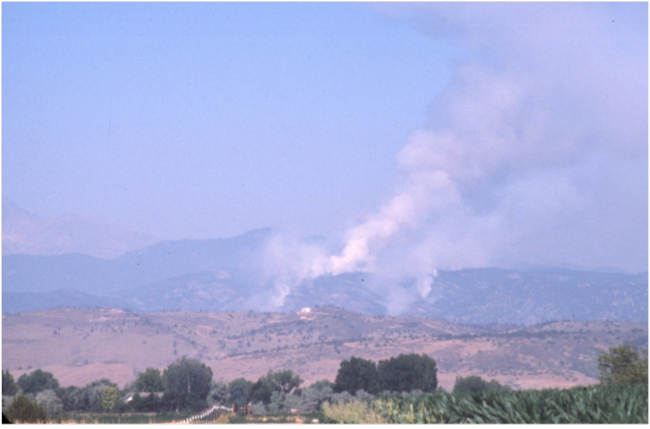
Smoke in Front Range foothills north of Boulder, July 2002
The moth, whose scientific name is Schinia masoni, is a flowermoth, a member of a group of moths whose larvae specialize in eating the developing seeds of their particular host flower. Each species has its own host plant, which in the case of Schinia masoni is Blanketflower – scientific name Gaillardia aristata.
Typical moths in the large and common moth family, the Noctuidae, to which Schinia masoni and other flowermoths belong, are drab, dark-colored, mottled. Picture grey, brown, black, salt-and-pepper. Typical noctuid moths are camouflaged when they rest on tree bark, rocks, or lichens. But flowermoths, a subfamily of this large group, are camouflaged on the flowers of their larval host plant and adult nectar plant – picture pink, purple, red, yellow, white! Colorful camouflage may sound contradictory, but not for the flowermoths. Schinia masoni is flaming red and yellow – and very hard to see when resting on Blanketflower! The striking and beautiful colors of the flower and the moth reflect the fiery flames that have shaped their co-evolution. Its camouflage is another reason, besides its rarity, that not many people have seen the Colorado Firemoth.
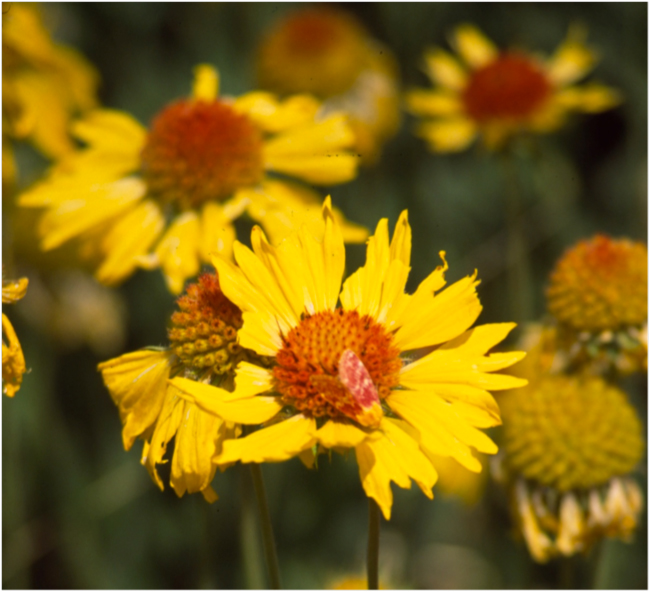
Schinia masoni resting in camouflaged position on Blanketflower
Now in late June, Blanketflower is just coming into bloom in grasslands and meadows scattered in the pine forests along the Front Range. It turns out that Blanketflower is what ecologists call a “fire dependent” species. After a fire has burned through the pine woods here, Blanketflower seeds waiting in the soil germinate in abundance, and for a few years the woods can be thick with their sunflower-like blossoms, fiery yellow and red. Within one year after a fire, Blanketflower becomes a dominant component of the understory vegetation at many burned sites. But if you look in a dense, dark pine forest that hasn’t burned in a few decades – like the Black Forest area where the recent fire burned – you won’t see many Blanketflowers at all. And so, of course, when fires have been suppressed and the pines have grown unnaturally thick, not only are Blanketflowers rare, but so is the moth that depends on them.
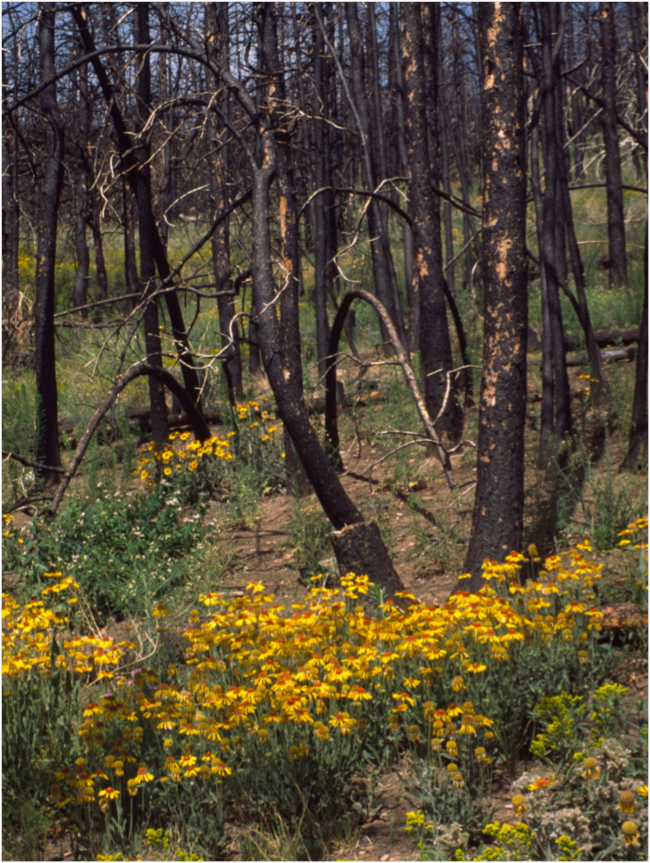
Blanketflower release at Bobcat Gulch in July 2002, after a fire in 2000
About ten years ago, after doing a few years of fire ecology research under a cooperative research agreement with the US Forest Service, I argued that Schinia masoni was a sensitive “indicator species” for the naturalness – or unnaturalness – of Colorado Front Range ponderosa pine and mixed conifer forests. Because of its evolved dependence on a fire-dependent host plant, and because it is found only in the Front Range of Colorado (barely into southern Wyoming), I proposed to call this species the “Colorado Firemoth.”
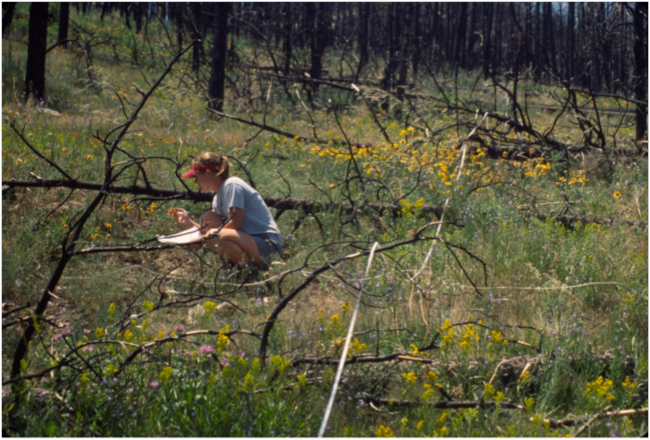
Collecting data on Blanketflowers and Firemoths at Bobcat Gulch, July 2002 (with Anya Byers, research assistant)
My research showed that Blanketflower nearly disappears by a century after the last fire, but it may persist at some sites for up to about 50 years without a new burn to “release” it. Firemoths colonize Blanketflower populations on some, but not all, burned sites within two years. Moths persist at significant densities even as Blanketflower populations decline dramatically over 50 years following a fire. Because Blanketflowers virtually disappear from unburned pine forests within a century, Firemoths have to disperse and colonize Blankeflower populations in newly-burned areas to survive. Like many species that live in what ecologists call “early-successional” communities, these moths must exist as a “metapopulation” – that is, a shifting mosaic of temporary populations linked by some degree of migration.
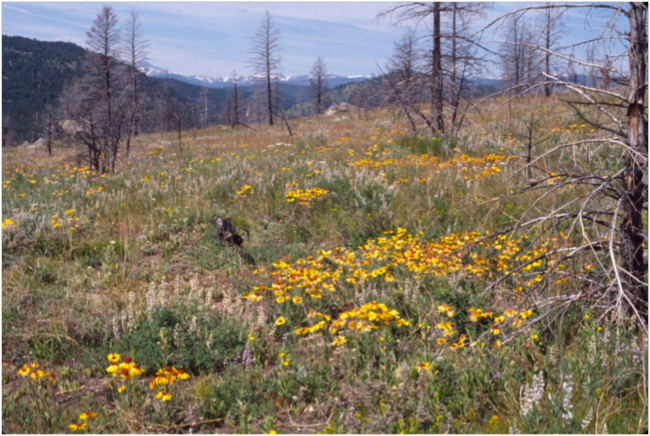
Blanketflower abundance in July 1992 in area burned by Black Tiger Fire of 1989

The Colorado Firemoth, illustration from The Charcoal Forest: How Fire Helps Animals and Plants (Beth Peluso, 2007).
What was the historically “natural” forest landscape in the Colorado Front Range? The most detailed reconstruction of what these forests must have looked like comes from fire history studies conducted at Cheesman Reservoir by US Forest Service researcher Merrill Kaufmann and his colleagues. Ironically, this study area was completely burned by the extremely intense Hayman Fire in 2002. The 800-year fire history from this site showed a mean fire interval of about 50 years, with a patchy, mixed-severity fire regime – that is, a range of fire severity from low-intensity understory fires to those that crown, burning every tree and leading to eventual replacement of the forest in intensely-burned patches. This fire regime resulted in a crown closure of 30% or less. It was an open, heterogeneous landscape, with a mixture of pine forest and meadows – an open, pine-savanna woodland. The research at Cheesman Reservoir suggested that this was probably typical of Front Range forests at elevations between about 5,500 and 8,500 feet, although generalizing from one site to another is controversial. Some researchers argue that at higher elevations, in the mixed-conifer forests where lodgepole pine and Douglas fir enter the forest mix, fire frequency was less, and the severity of fires greater.
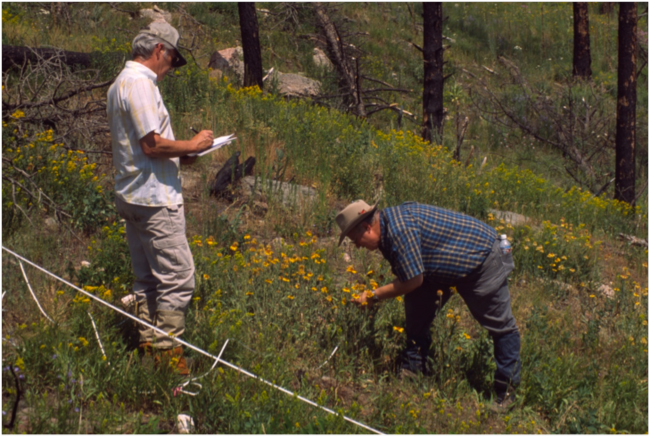
Collecting data on blanketflowers and firemoths at Bobcat Gulch, June 2003 (with Merrill Kaufmann (left) and Brian Kent, US Forest Service)
The Cheesman Reservoir study makes it possible to describe how the historical, “natural” reference conditions of Front Range forests have changed in approximately the last thousand years. In the historic fire regime, 2.5%, or about 100,000 acres, burned every year on average. In other words, more area burned in the past than now. Openings of one to one-hundred acres were created by patchy crown fires in a mixed-severity fire regime. The total area of hotly-burned patches (and therefore of blanketflower release) was much larger in the past, and the average size of those patches was much smaller than today – so they were much closer together. In such a landscape, the Firemoth would not have had to fly far to discover a newly-burned-and-released patch of Blanketflowers. Under such conditions, Schinia masoni would have been much more abundant. Thus, the abundance – or rarity – of the Colorado Firemoth should be an indicator of the departure from a historically-natural, fire-created forest landscape up and down the Colorado Front Range.
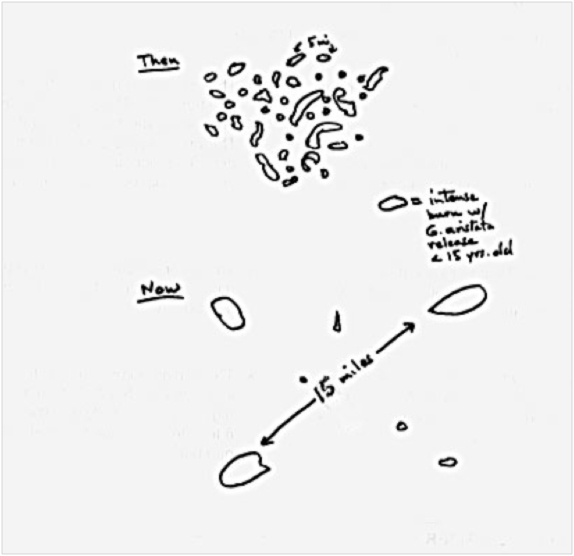
Comparing the historical and current distribution of intensely-burned patches with Blanketflower release, back of envelope sketch, 2004
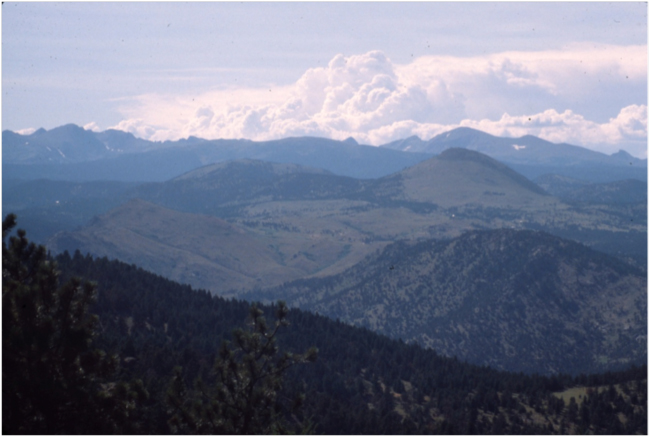
Gold Hill-Sugarloaf Mountain landscape of fire-created meadows and ponderosa pine woodland looking north from Flagstaff Mountain, Boulder County, Colorado
The Colorado Firemoth has the right characteristics to be a sensitive indicator species for fire-created landscape structure: it has a complete, evolved dependence on a fire-dependent host plant, and it exists as a metapopulation dependent on the size and frequency of fires that create conditions for release of its host plant. It is the equivalent of a “canary in a coal mine” as far as predicting the long-term fire risk in these forests: when the Firemoth is rare, Colorado beware!
Earlier I said this moth has an ecological lesson for us. And what is that? The lesson is that living in and loving ponderosa pine and mixed-conifer forests along the Colorado Front Range also means accepting and trying to restore the natural, historical fire regime of these forests. City and county planners, housing developers, homeowners, firefighters, and insurance companies need to learn this lesson from the little Colorado Firemoth.
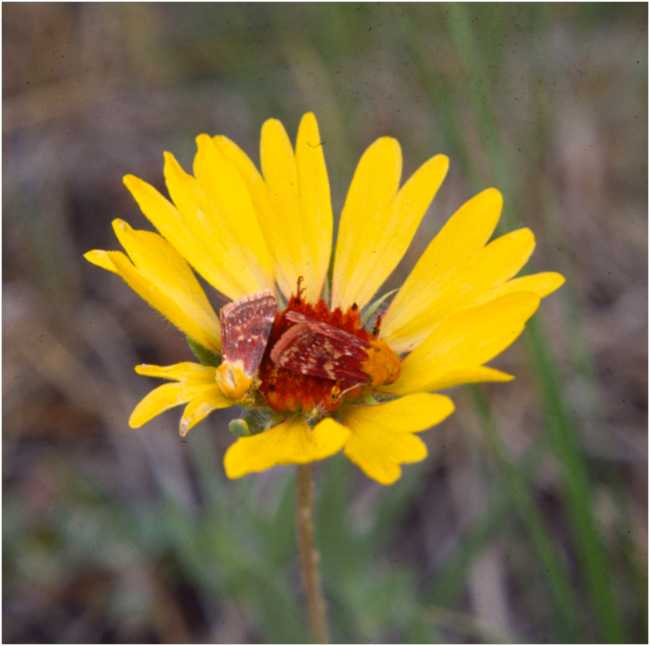
Firemoth pair on blanketflower
If you live along the Colorado Front Range, go in the next two or three weeks to the meadows in pine woodlands that have burned in the last decade, and look for a bright wildflower, and its rare friend, the Colorado Firemoth. If you miss it this year, go next year or the year after that to an area that burned this year. Blanketflowers will be there, and so will the Colorado Firemoth.
Related links:
- A Beautiful Relationship. Exhibit at the University of Colorado Museum.
- Byers, Bruce A. 1989. Biology and Immature Stages of Schinia masoni (Noctuidae). Journal of the Lepidopterists’ Society. 43(3), 1989, 210-216.
- Kaufmann, M.R., L. Huckaby, and P. Gleason. 2000. Ponderosa pine in the Colorado Front Range: Long historical fire and tree recruitment intervals and a case for landscape heterogeneity. Proceedings, Joint Fire Science Conference and Workshop, Boise, ID, June 1999. Vol 1, pp. 153-160.
- Peluso, Beth. 2007. The Charcoal Forest: How Fire Helps Animals and Plants.

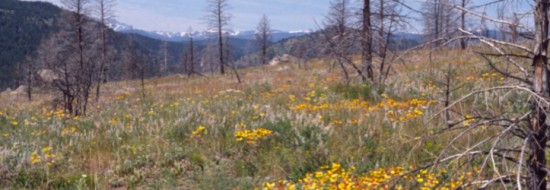



June 29, 2013 2:42 am
This is a great one, Bruce–well done! I’m forwarding it to Colorado family and others who will appreciate the story and your telling of it. A few days ago I showed one of your fine photos of S. masoni on Gaillardia to 100+ high school students from around the country at the Student Climate and Conservation Congress at the National Conservation Training Center in Shepherdstown, West Virginia. I used it as an elegant example of crypsis, better than any camo from Cabela’s. But had I read your blog first, the moth would have doubled as a great link into the main topic of my talk, “Butterflies and Climate Change.”
Thanks for a thoughtful and fascinating essay!
Bob
July 3, 2013 5:58 pm
Thank you for the comment, Bob!
I didn’t raise the climate change issue here, but you saw through to it, it seems. The head of the U.S. Forest Service, Tom Tidwell, has been making statements to Congress recently that blame the increase in large, intense fires over the last decade on climate change. Probably partly true – shorter, warmer winters, faster snowmelt, and longer, hotter summers would add up to cause a longer fire season. But the increase must also be because we are finally feeling the effects of wildfire suppression policies going back a hundred years. It was forest management decisions that created the unnaturally dense and uniform forests that now cover the west. In fact, the increase in fires is probably due both to historical fire suppression and climate change. No matter what the cause, the Colorado Firemoth will probably become more common.
July 19, 2013 2:34 pm
[…] Here’s a cool blog post about Schinia masoni, the Colorado firemoth. […]
November 17, 2013 9:55 pm
[…] For my previous story on Colorado fire ecology and the Colorado Firemoth, read Colorado Fires and Firemoths […]